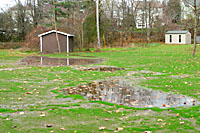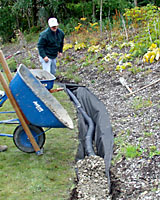Terry L. Ettinger Horticulture Consulting Services
Meeting The Needs Of Today With A Vision For The Future
Special Topics
Plants for Wet Soils
Introduction
Where I grew up in Illinois, the soils were very sandy and extremely well-drained. Even after days of heavy rain, it took only a couple of dry days for breezes to raise dust from the fields on my grandparentís farm.
This certainly isn't the case across much of Central New York.
 Here, soils often have a high content of clay and are very poorly drained. In these places, water often stands for days,
or even weeks after a stretch of rainy weather. There are even neighborhoods where any hole thatís dug quickly fills with
water thatís "perched" on top of poorly drained subsoilóeven weeks after the last rainfall!
Here, soils often have a high content of clay and are very poorly drained. In these places, water often stands for days,
or even weeks after a stretch of rainy weather. There are even neighborhoods where any hole thatís dug quickly fills with
water thatís "perched" on top of poorly drained subsoilóeven weeks after the last rainfall!
In places where soils remain wet for long periods of time, it can be impossible to grow many of the most
 popular
landscape plants. Yews, rhododendrons and azaleas, roses, and even common lawn grasses such as Kentucky bluegrass, fine
fescue, and perennial ryegrass don't grow well, or sometimes at all in wet soils. And, while itís possible to modify
sites by installing raised beds and/or below-ground drainage in order to grow our favorite plants, it can be very
expensive and is frequently only marginally effective.
popular
landscape plants. Yews, rhododendrons and azaleas, roses, and even common lawn grasses such as Kentucky bluegrass, fine
fescue, and perennial ryegrass don't grow well, or sometimes at all in wet soils. And, while itís possible to modify
sites by installing raised beds and/or below-ground drainage in order to grow our favorite plants, it can be very
expensive and is frequently only marginally effective.
A better alternative, I think, is to treat wet soils as a landscape asset and select plants that can adapt to those areas of your landscape and garden that are occasionally to persistently wet. For lists of such plants, just click on the links at right.